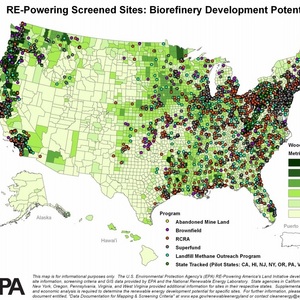EPA seeks comments on RE-Powering initiative draft action plan




U.S. EPA
May 8, 2014
BY Erin Krueger
The U.S. EPA is seeking public comments on its new draft action plant for the RE-Powering America’s Land Initiative. The program promotes renewable energy development on current and formerly contaminated lands, landfills and mine sites.
In August 2013, the EPA announced an update of its RE-Powering Mapping and Screening Tool. The updated tool showed vast potential for the development of bioenergy projects on contaminated lands, landfills and mine sites. According to the EPA, the updated tool identified 9,591 sites as potential locations for biorefinery facilities, 9,666 sites for potential biopower development and 1,947 sites as potential locations for landfill gas energy projects. To date, however, most projects developed through the initiative focus on wind or solar power generation. Of the 110 installations developed so far, only one is a biomass project. That project, the 20 MW Savannah River’s Biomass Steam Plant, is located on a Superfund site in Aiken, S.C.
Advertisement
Advertisement
The new action plan details specific activities for the RE-Power initiative over the next two years. The first goal identified in the draft action plan is to provide technical and programmatic assistance, including the development and enhancement of program tools and the acceleration of projects, in part, through the RE-Powering Rapid Response Team. In the draft, the EPA notes that it has successfully partnered with the National Renewable Energy Laboratory to articulate and disseminate the characteristics associated with renewable energy on contaminated lands, particularly solar and wind technologies. The EPA said it plans to continue such partnership efforts and explore opportunities for biomass, including biopower and biodigesters, on contaminated lands. “This inquiry will provide the Initiative insight on whether to enhance its efforts on biomass vis à vis other renewable technologies,” said the EPA in the draft plan.
The second goal is to promote policies and best practices to encourage renewable energy on contaminated lands. To achieve that goal, the EPA proposes to highlight and analyze policies and programs at the federal, state, local and tribal level, and to better communicate opportunities, evaluate successes and disseminate lessons learned.
Advertisement
Advertisement
The agency’s third goal is to partner with stakeholders and leverage agency efforts through coordination and collaboration with other federal agencies and by engaging public and private stakeholders to build capacity.
A full copy of the draft plan can be downloaded from the EPA’s website. Comments are due May 30, and can be emailed to cleanenergy@epa.gov.
Related Stories
The U.S. Department of Energy Bioenergy Technologies Office (BETO) announced up to $23 million in funding to support research and development (R&D) of domestic chemicals and fuels from biomass and waste resources.
The U.S. DOE has announced its intent to issue funding to support high-impact research and development (R&D) projects in two priority areas: sustainable propane and renewable chemicals and algal system cultivation and preprocessing.
Sens. Sherrod Brown, D-Ohio, and Pete Ricketts, R-Neb., in August introduced the Renewable Chemicals Act, a bill that aims to create a tax credit to support the production of biobased chemicals.
The Chemical Catalysis for Bioenergy Consortium, a consortium of the U.S. DOE’s Bioenergy Technologies Office, has launched an effort that aims to gather community input on the development of new biomass processing facilities.
USDA on March 8 celebrated the second annual National Biobased Products Day, a celebration to raise public awareness of biobased products, their benefits and their contributions to the U.S. economy and rural communities.
Upcoming Events










